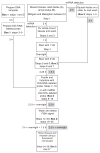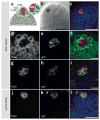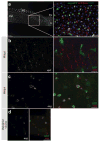Dual fluorescence detection of protein and RNA in Drosophila tissues
- PMID: 22976352
- PMCID: PMC4821427
- DOI: 10.1038/nprot.2012.105
Dual fluorescence detection of protein and RNA in Drosophila tissues
Abstract
Detection of RNAs by in situ hybridization (ISH) is a well-established technique that permits the study of specific RNA expression patterns in tissues; however, not all tissues are equally amenable to staining using the same procedure. Here we describe a protocol that combines whole-mount immunofluorescence (IF) and fluorescence in situ hybridization (FISH) for the simultaneous detection of specific RNA transcripts and proteins, greatly enhancing the spatial resolution of RNA expression in complex, intact fly tissues. To date, we have successfully used this protocol in adult testis, larval male gonads, adult intestine and Malpighian tubules. IF is conducted in RNase-free solutions, prior to the harsh conditions of FISH, in order to preserve protein antigenicity within dissected tissues. Separate protocols are described for mRNA and miRNA detection, which are based on robust digoxigenin (DIG) RNA and locked nucleic acid (LNA) probes, respectively. The combined IF-FISH procedure can be completed in 2 d for miRNA detection and 4 d for mRNA detection. Although optimized for Drosophila, this IF-FISH protocol should be adaptable to a wide variety of organisms, tissues, antibodies and probes, thus providing a reliable and simple means to compare RNA and protein abundance and localization.
Conflict of interest statement
Figures





Similar articles
-
Optimized RNA ISH, RNA FISH and protein-RNA double labeling (IF/FISH) in Drosophila ovaries.Nat Protoc. 2013 Nov;8(11):2158-79. doi: 10.1038/nprot.2013.136. Epub 2013 Oct 10. Nat Protoc. 2013. PMID: 24113787 Free PMC article.
-
sRNA-FISH: versatile fluorescent in situ detection of small RNAs in plants.Plant J. 2019 Apr;98(2):359-369. doi: 10.1111/tpj.14210. Epub 2019 Feb 12. Plant J. 2019. PMID: 30577085 Free PMC article.
-
Combined whole-mount fluorescence in situ hybridization and antibody staining in zebrafish embryos and larvae.Nat Protoc. 2020 Oct;15(10):3361-3379. doi: 10.1038/s41596-020-0376-7. Epub 2020 Sep 9. Nat Protoc. 2020. PMID: 32908315
-
Determination of gene expression patterns using in situ hybridization to Drosophila testes.Nat Protoc. 2009;4(12):1807-19. doi: 10.1038/nprot.2009.192. Nat Protoc. 2009. PMID: 20010932
-
Whole mount RNA fluorescent in situ hybridization of Drosophila embryos.J Vis Exp. 2013 Jan 30;(71):e50057. doi: 10.3791/50057. J Vis Exp. 2013. PMID: 23407302 Free PMC article.
Cited by
-
Escargot restricts niche cell to stem cell conversion in the Drosophila testis.Cell Rep. 2014 May 8;7(3):722-34. doi: 10.1016/j.celrep.2014.04.025. Epub 2014 May 1. Cell Rep. 2014. PMID: 24794442 Free PMC article.
-
Combination of Immunofluorescence and Quantitative Fluorescence In-situ Hybridization for Analysing Differential Gene Expression in the Niche Cells of the Drosophila Lymph Gland.Bio Protoc. 2022 Jan 20;12(2):e4290. doi: 10.21769/BioProtoc.4290. eCollection 2022 Jan 20. Bio Protoc. 2022. PMID: 35127980 Free PMC article.
-
Loss-of-function analysis reveals distinct requirements of the translation initiation factors eIF4E, eIF4E-3, eIF4G and eIF4G2 in Drosophila spermatogenesis.PLoS One. 2015 Apr 7;10(4):e0122519. doi: 10.1371/journal.pone.0122519. eCollection 2015. PLoS One. 2015. PMID: 25849588 Free PMC article.
-
Eye development.Methods. 2014 Jun 15;68(1):252-9. doi: 10.1016/j.ymeth.2014.04.007. Epub 2014 Apr 29. Methods. 2014. PMID: 24784530 Free PMC article. Review.
-
Relish plays a dynamic role in the niche to modulate Drosophila blood progenitor homeostasis in development and infection.Elife. 2021 Jul 22;10:e67158. doi: 10.7554/eLife.67158. Elife. 2021. PMID: 34292149 Free PMC article.
References
-
- Speel EJ, Hopman AH, Komminoth P. Amplification methods to increase the sensitivity of in situ hybridization: play card(s) J Histochem Cytochem. 1999;47:281–288. - PubMed
-
- Speel EJ, Saremaslani P, Roth J, Hopman AH, Komminoth P. Improved mRNA in situ hybridization on formaldehyde-fixed and paraffin-embedded tissue using signal amplification with different haptenized tyramides. Histochem Cell Biol. 1998;110:571–577. - PubMed
-
- Baldino F, Chesselet MF, Lewis ME., Jr High-resolution in situ hybridization histochemistry. Methods Enzymol. 1989;168:761–777. - PubMed
-
- Springer JE, Robbins E, Gwag BJ, Lewis ME, Baldino F., Jr Non-radioactive detection of nerve growth factor receptor (NGFR) mRNA in rat brain using in situ hybridization histochemistry. J Histochem Cytochem. 1991;39:231–234. - PubMed
-
- Bobrow MN, Litt GJ, Shaughnessy KJ, Mayer PC, Conlon J. The use of catalyzed reporter deposition as a means of signal amplification in a variety of formats. J Immunol Methods. 1992;150:145–149. - PubMed
Publication types
MeSH terms
Substances
Grants and funding
LinkOut - more resources
Full Text Sources
Molecular Biology Databases
Miscellaneous

